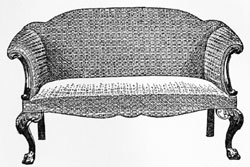Broken and Vertical Lines within Interior Decorating
Broken lines, by reason of their sudden changes, suggest the ideas of life and animation. While such lines may appear as dentil mouldings in cornice, mantel or reading table, or in the bottom lined of lambrequins, they have little place in the fixed decorations of a room-that is, in walls, openings, floor coverings, hangings and the large immovable pieces of furniture-which are by nature tranquil and relatively solemn. Broken lines are appropriately used in chair backs, screens, book-blocks with a row of books between, and pillows that break the long back line of couch or davenport, because it is one of the functions of these light and relatively unimportant elements to give life

FIGURE 5.-The legs of this sofa reveal a degree of curvature too marked for the weight they bear. The curves of the back are weak and lacking in distinction; those of the front are commonplace and lacking in subtlety.
and animation to a room. Broken lines are always to be used sparingly, since too many of them perplex and fatigue the eye, and particular care must be taken to avoid any appearance of arithmetical progression, which, as in the case of small pictures or photographs so arranged that they present a series of steps, inevitably catch the attention, lead it to the top, and there leave it suspended, thus destroying the poiseand symmetry of the wall. It sometimes happens, particularly in small and inexpensively built houses, that the tops of windows in the same room are on slightly different levels, so that they present a disturbing effect of broken and irregular line. Whenever possible this defect should be corrected by the use of a valance hung far enough above the lower window to bring the apparent tops to the same level.

FIGURE 6.-The three faces express, with remarkable clearness, the ideas of the calmness, of gaiety, and of desolate sadness. These faces are identical except for the direction of the broken lines.
Broken lines may be made to suggest ideas of gaiety or gravity, in the arrangement of mantel, bookcase or table ornaments, or in the arrangement of groups of furniture, according to whether their tops form a V upright or inverted. The principle involved, which lies at the basis of expression in the visual arts, is illustrated in the curious old drawing of Humbert de Superville.
Horizontal lines express the ideas of calmness, quiescence and repose; vertical lines of support, activity and life. In the degree that either horizontal or vertical lines are long and straight they add to their primary significance the ideas of permanence and dignity. Straight horizontal lines give to any composition in which they are dominant an effect of quietude and duration; straight vertical lines of firmness, and when over-emphasized, of stiffness and even of sternness. The function and employment of horizontal and vertical extension, and of the lines by which they are defined, will be developed in the chapter on proportion.
Vertical lines tend to express as well as to arouse emotions of exaltation and inquietude. Owing to the relatively short length of any lines inside a room this effect is rarely perceptible except by abnormally sensitive persons, but it is clearly felt in monumental architecture. The Gothic cathedrals perfectly expressed the sentiments of inquietude and exaltation that possessed the soul of northern Europe in the later Middle Ages, and they tend to arouse the same emotions in the soul of the beholder today. The feeling that takes possession of one who from the Hudson river sees the shaft-like buildings of lower New York outlined against a twilight shy, or who stands at the foot of the Washington Monument or the Sather Tower at Berkeley and follows the seemingly endless verticals as they appear to erect themselves, by sheer force of aspiration, heavenward, is inspired by the same power of line.
 "Finally! Step-by-Step Guidebooks Show
"Finally! Step-by-Step Guidebooks Show